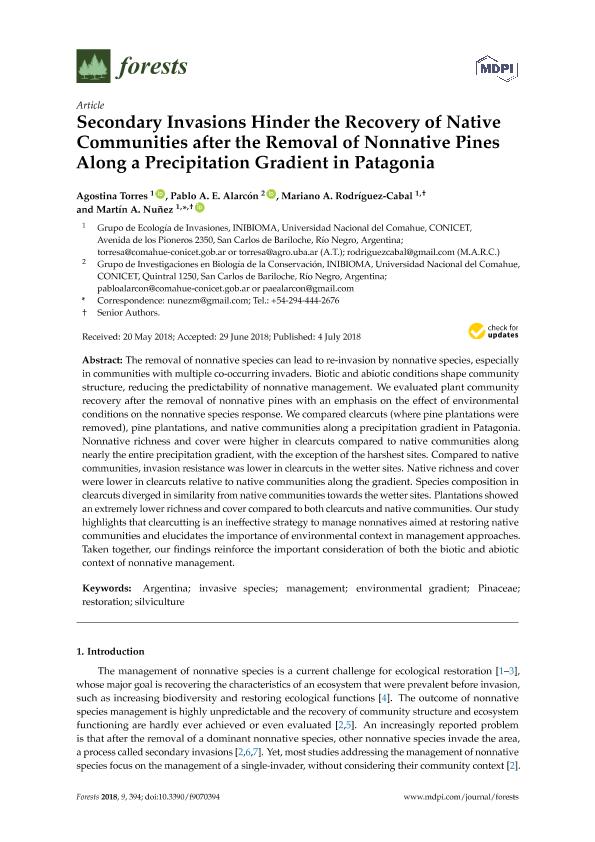Artículo
Secondary invasions hinder the recovery of native communities after the removal of nonnative pines along a precipitation gradient in Patagonia
Torres, Agostina ; Alarcón, Pablo Angel Eduardo
; Alarcón, Pablo Angel Eduardo ; Rodriguez Cabal, Mariano Alberto
; Rodriguez Cabal, Mariano Alberto ; Nuñez, Martin Andres
; Nuñez, Martin Andres
 ; Alarcón, Pablo Angel Eduardo
; Alarcón, Pablo Angel Eduardo ; Rodriguez Cabal, Mariano Alberto
; Rodriguez Cabal, Mariano Alberto ; Nuñez, Martin Andres
; Nuñez, Martin Andres
Fecha de publicación:
04/07/2018
Editorial:
MDPI AG
Revista:
Forests
ISSN:
1999-4907
Idioma:
Inglés
Tipo de recurso:
Artículo publicado
Clasificación temática:
Resumen
The removal of nonnative species can lead to re-invasion by nonnative species, especially in communities with multiple co-occurring invaders. Biotic and abiotic conditions shape community structure, reducing the predictability of nonnative management. We evaluated plant community recovery after the removal of nonnative pines with an emphasis on the effect of environmental conditions on the nonnative species response. We compared clearcuts (where pine plantations were removed), pine plantations, and native communities along a precipitation gradient in Patagonia. Nonnative richness and cover were higher in clearcuts compared to native communities along nearly the entire precipitation gradient, with the exception of the harshest sites. Compared to native communities, invasion resistance was lower in clearcuts in the wetter sites. Native richness and cover were lower in clearcuts relative to native communities along the gradient. Species composition in clearcuts diverged in similarity from native communities towards the wetter sites. Plantations showed an extremely lower richness and cover compared to both clearcuts and native communities. Our study highlights that clearcutting is an ineffective strategy to manage nonnatives aimed at restoring native communities and elucidates the importance of environmental context in management approaches. Taken together, our findings reinforce the important consideration of both the biotic and abiotic context of nonnative management.
Archivos asociados
Licencia
Identificadores
Colecciones
Articulos(INIBIOMA)
Articulos de INST. DE INVEST.EN BIODIVERSIDAD Y MEDIOAMBIENTE
Articulos de INST. DE INVEST.EN BIODIVERSIDAD Y MEDIOAMBIENTE
Citación
Torres, Agostina; Alarcón, Pablo Angel Eduardo; Rodriguez Cabal, Mariano Alberto; Nuñez, Martin Andres; Secondary invasions hinder the recovery of native communities after the removal of nonnative pines along a precipitation gradient in Patagonia; MDPI AG; Forests; 8; 2; 4-7-2018; 1-18
Compartir
Altmétricas



